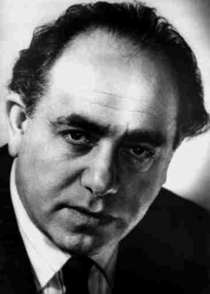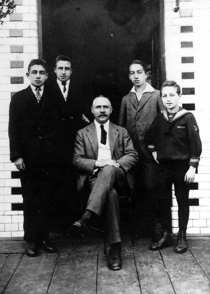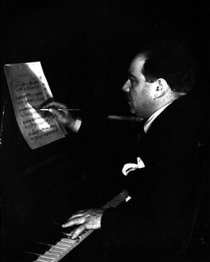Eric Zeisl (1905-1959)
 Eric Zeisl was born in Vienna on May 18, 1905. From childhood, he
demonstrated an unshakable resolve to compose. Against strong family
resistance, he entered the Vienna State Academy at age fourteen. Two
years later, his first publication appeared, a set of songs. Despite
acclaim as one of Austria's brightest young compositional lights, Zeisl
eventually fell victim to Europe's gathering political storm. In
November, 1938, he fled Vienna for Paris and temporary refuge, but it
was only upon reaching America in September, 1939 that he found
permanent sanctuary. Against formidable odds, he achieved recognition
in his adopted land, with praise for his work coming from fellow
composers
Erich Wolfgang Korngold,
Darius Milhaud,
Igor Stravinsky,
Mario Castelnuovo-Tedesco,
Alexandre Tansman,
Hanns Eisler,
Ernst Toch, and
Alma Mahler-Werfel,
among others. Then, on February 18, 1959, at the age of 53 and at
the height of his creative powers, Eric Zeisl suffered a heart attack
after teaching an evening class at
Los Angeles City College. He died that night."
(Prof. Malcolm Cole, author of
Armseelchen: The Life and Music of Eric Zeisl, published by
Greenwood Press.)
Eric Zeisl was born in Vienna on May 18, 1905. From childhood, he
demonstrated an unshakable resolve to compose. Against strong family
resistance, he entered the Vienna State Academy at age fourteen. Two
years later, his first publication appeared, a set of songs. Despite
acclaim as one of Austria's brightest young compositional lights, Zeisl
eventually fell victim to Europe's gathering political storm. In
November, 1938, he fled Vienna for Paris and temporary refuge, but it
was only upon reaching America in September, 1939 that he found
permanent sanctuary. Against formidable odds, he achieved recognition
in his adopted land, with praise for his work coming from fellow
composers
Erich Wolfgang Korngold,
Darius Milhaud,
Igor Stravinsky,
Mario Castelnuovo-Tedesco,
Alexandre Tansman,
Hanns Eisler,
Ernst Toch, and
Alma Mahler-Werfel,
among others. Then, on February 18, 1959, at the age of 53 and at
the height of his creative powers, Eric Zeisl suffered a heart attack
after teaching an evening class at
Los Angeles City College. He died that night."
(Prof. Malcolm Cole, author of
Armseelchen: The Life and Music of Eric Zeisl, published by
Greenwood Press.)
 Zeisl's music is richly tonal, but with a modern sensibility. Prof.
Malcolm Cole describes his style as "notable for expressive melody,
rich harmonies, strong dance-derived rhythms, and imaginative scoring."
He was perhaps the youngest of the once successful emigré composers who
were forced to abandon their careers and flee Europe. Zeisl was hurt
more than most because his reputation had not yet been secured. He won
an Austrian state prize in 1934 (for a Requiem Mass), but because he
was a Jew he could not secure a publishing contract since his works
would have by that time been banned in Germany, the primary market. (He
was just 29 years old.) Despite this disadvantage, the Viennese
publishers
Universal Edition and
Ludwig Doblinger published Zeisl's orchestral works and songs in the 1930's. The
Anschluss
in March 1938 abruptly ended hopes of any future Central European
publications or performances including the planned premieres of Zeisl's
comic opera
Leonce and Lena (after
Georg Büchner) by Radio Prague and at Vienna's
Schönbrunn Schlosstheater.
Zeisl's music is richly tonal, but with a modern sensibility. Prof.
Malcolm Cole describes his style as "notable for expressive melody,
rich harmonies, strong dance-derived rhythms, and imaginative scoring."
He was perhaps the youngest of the once successful emigré composers who
were forced to abandon their careers and flee Europe. Zeisl was hurt
more than most because his reputation had not yet been secured. He won
an Austrian state prize in 1934 (for a Requiem Mass), but because he
was a Jew he could not secure a publishing contract since his works
would have by that time been banned in Germany, the primary market. (He
was just 29 years old.) Despite this disadvantage, the Viennese
publishers
Universal Edition and
Ludwig Doblinger published Zeisl's orchestral works and songs in the 1930's. The
Anschluss
in March 1938 abruptly ended hopes of any future Central European
publications or performances including the planned premieres of Zeisl's
comic opera
Leonce and Lena (after
Georg Büchner) by Radio Prague and at Vienna's
Schönbrunn Schlosstheater.
 After narrowly escaping capture during the
Kristallnacht
pogrom of November 9, 1938, Zeisl and his wife fled from Vienna,
settling first in Paris, where Zeisl began his lasting friendship with
Darius Milhaud.
Upon his arrival in New York at the end of 1939, Zeisl obtained a
number of radio performances (and received an unused recommendation
from Hanns Eisler for study with
Arnold Schoenberg), but he was soon lured to Hollywood, where he suffered from being a late-comer to the movies. He worked on
a number of well-known films,
but never received a screen credit. He soon abandoned film music and
returned to serious composition.
In 1944-45 Zeisl composed the Requiem Ebraico, a setting of the 92nd psalm, dedicated to his father
and the countless other victims of the Jewish tragedy in Europe. The work is today considered the first
major work of Holocaust commemoration and has been performed by orchestras throughout the world, including
the Vienna Philharmonic and the Israel Philharmonic.
After narrowly escaping capture during the
Kristallnacht
pogrom of November 9, 1938, Zeisl and his wife fled from Vienna,
settling first in Paris, where Zeisl began his lasting friendship with
Darius Milhaud.
Upon his arrival in New York at the end of 1939, Zeisl obtained a
number of radio performances (and received an unused recommendation
from Hanns Eisler for study with
Arnold Schoenberg), but he was soon lured to Hollywood, where he suffered from being a late-comer to the movies. He worked on
a number of well-known films,
but never received a screen credit. He soon abandoned film music and
returned to serious composition.
In 1944-45 Zeisl composed the Requiem Ebraico, a setting of the 92nd psalm, dedicated to his father
and the countless other victims of the Jewish tragedy in Europe. The work is today considered the first
major work of Holocaust commemoration and has been performed by orchestras throughout the world, including
the Vienna Philharmonic and the Israel Philharmonic.
Zeisl was composer-in-residence at the Brandeis-Bardin Institute and at the Huntington Hartford Foundation. At Los Angeles City College, his students included oscar-winning film composer Jerry Goldsmith. The composers Leon Levitch, Robin Frost, Jack Millman and Julie Mandel also studied with Zeisl. In Hollywood, Zeisl composed a piano concerto, cello concerto (for Gregor Piatigorsky), four ballets, numerous choral and chamber works, and half of an unfinished opera, before being felled by a heart attack after teaching the composition theory class (later taught by Ernst Krenek) at Los Angeles City College on February 18, 1959.